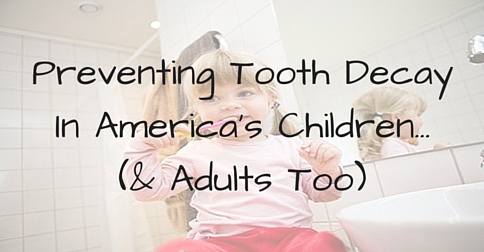 Cavities in our kids are on the decline.
Cavities in our kids are on the decline.
Yet, the majority of America’s youth have experienced tooth decay by high school, and there is a subset of youngsters who remain at very high risk of (more) cavities throughout adulthood.
Accordingly, filling decayed teeth remains one of the top 5 most common chronic diseases in America, and for the many who are uninsured or partly insured, the most expensive to treat.
In the American healthcare budget, more is spent on fixing decayed teeth than is spent on managing many cancers.
The conventional view is that if these at-risk children were to see a dentist frequently, there would be less decay. And this is probably true.
Another common argument is that if these kids drank less pop, ate fewer sweets and consistently brushed their teeth, there would be fewer cavities. Again, this is perhaps true.
These views are commonly expressed by professional dentistry and by articles such as this one: http://www.opposingviews.com/i/society/doctors-warn-parents-about-dangers-tooth-decay.
But is this a realistic, or indeed, scientific, approach to preventing cavities in America’s kids and even America’s adults?
After all, this approach depends on more resources for an already stretched healthcare system and employee benefit program, and it relies on patient behavior. Neither is a good basis for improving health outcomes (better oral health) at lower cost.
The starting point for managing any chronic disease must be to address the cause of this disease.
In the case of dental decay, this means correcting the imbalance of bacteria on the tooth surface, also known as dysbiosis.
In a mouth getting cavities, the bacteria biofilm (called plaque) has a different composition and structure than in a healthy mouth.
This imbalance results from 2 primary factors.
1. In kids, dysbiosis stems from cross-infection from the mother when the child’s first teeth erupt.
2. In adults, the key risk factor is a dry mouth resulting from taking multiple medications daily.
So, visiting the dentist for more exams and cleanings, adjusting the diet, and regular brushing are only part of the answer to disease management in dentistry.
What we really need is a way of re-balancing the plaque – to take it from dysbiosis to symbiosis.
Fortunately, our company (CHX Technologies, Toronto) has worked this out and has shown in randomized controlled clinical trials, that a sustained-release high-strength antiseptic tooth coating delivers a level of prevention which is very high for long periods, and at an affordable level.
The coating is called Prevora and it is applied by the hygienist in a series of short, painless appointments with which the patient complies.
Prevora is approved uniquely to prevent cavities in high risk adults in Canada and Europe, and a new drug application to the FDA is planned for 2017.
Prevora promises a new preventive phase in oral health care.
This approach works to manage the cause of cavities, is safe, and addresses the access and affordability in dental care which cannot be overcome with conventional arguments.
This guest post was written by Ross Perry, of CHX Technologies.
 Ross Perry is President & Chairman of CHX Technologies. Ross has organized and led the international team of experts and suppliers who have commercialized Prevora. He is also responsible for the major grants from US research councils for Prevora’s controlled studies. Ross authors a frequent blog on several social media platforms on the changing landscape of dentistry. You can email Ross here, & connect with him on Twitter.
Ross Perry is President & Chairman of CHX Technologies. Ross has organized and led the international team of experts and suppliers who have commercialized Prevora. He is also responsible for the major grants from US research councils for Prevora’s controlled studies. Ross authors a frequent blog on several social media platforms on the changing landscape of dentistry. You can email Ross here, & connect with him on Twitter.

